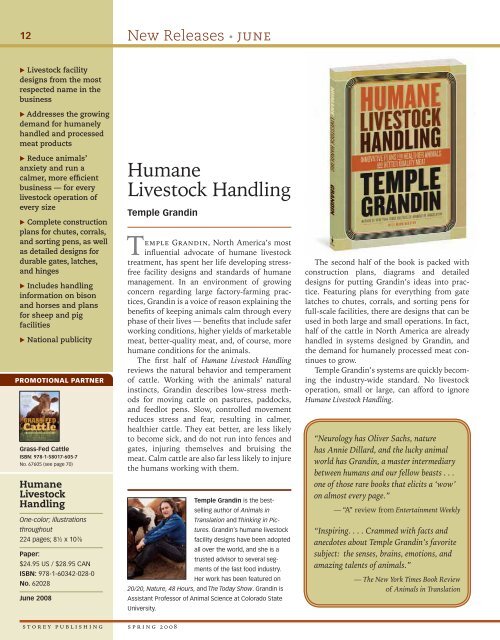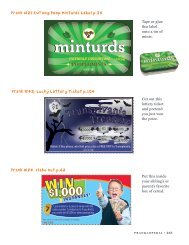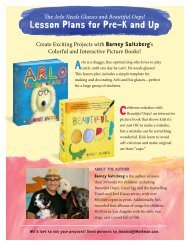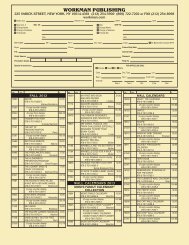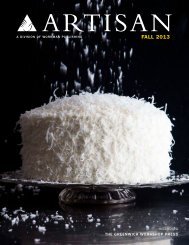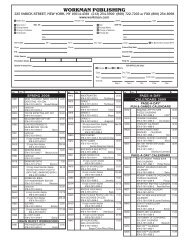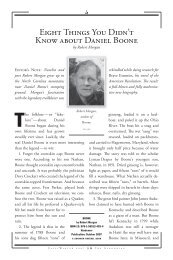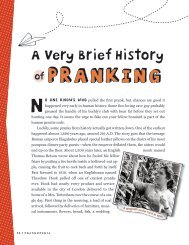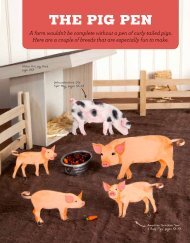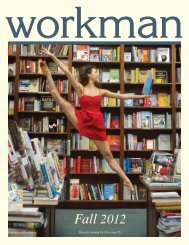Books for Country Living • Spring 2008 - Workman Publishing
Books for Country Living • Spring 2008 - Workman Publishing
Books for Country Living • Spring 2008 - Workman Publishing
- No tags were found...
You also want an ePaper? Increase the reach of your titles
YUMPU automatically turns print PDFs into web optimized ePapers that Google loves.
12 New Releases • june Livestock facilitydesigns from the mostrespected name in thebusiness Addresses the growingdemand <strong>for</strong> humanelyhandled and processedmeat products Reduce animals’anxiety and run acalmer, more efficientbusiness — <strong>for</strong> everylivestock operation ofevery size Complete constructionplans <strong>for</strong> chutes, corrals,and sorting pens, as wellas detailed designs <strong>for</strong>durable gates, latches,and hinges Includes handlingin<strong>for</strong>mation on bisonand horses and plans<strong>for</strong> sheep and pigfacilities National publicityPROMOTIONAL PARTNERGrass-Fed CattleISBN: 978-1-58017-605-7No. 67605 (see page 70)HumaneLivestockHandlingOne-color; illustrationsthroughout224 pages; Paper:$24.95 US / $28.95 CANISBN: 978-1-60342-028-0No. 62028June <strong>2008</strong>HumaneLivestock HandlingTemple GrandinT North America’s mostinfluential advocate of humane livestocktreatment, has spent her life developing stressfreefacility designs and standards of humanemanagement. In an environment of growingconcern regarding large factory-farming practices,Grandin is a voice of reason explaining thebenefits of keeping animals calm through everyphase of their lives — benefits that include saferworking conditions, higher yields of marketablemeat, better-quality meat, and, of course, morehumane conditions <strong>for</strong> the animals.The first half of Humane Livestock Handlingreviews the natural behavior and temperamentof cattle. Working with the animals’ naturalinstincts, Grandin describes low-stress methods<strong>for</strong> moving cattle on pastures, paddocks,and feedlot pens. Slow, controlled movementreduces stress and fear, resulting in calmer,healthier cattle. They eat better, are less likelyto become sick, and do not run into fences andgates, injuring themselves and bruising themeat. Calm cattle are also far less likely to injurethe humans working with them.Temple Grandin is the bestsellingauthor of Animals inTranslation and Thinking in Pictures.Grandin’s humane livestockfacility designs have been adoptedall over the world, and she is atrusted advisor to several segmentsof the fast food industry.Her work has been featured on20/20, Nature, 48 Hours, and The Today Show. Grandin isAssistant Professor of Animal Science at Colorado StateUniversity.The second half of the book is packed withconstruction plans, diagrams and detaileddesigns <strong>for</strong> putting Grandin’s ideas into practice.Featuring plans <strong>for</strong> everything from gatelatches to chutes, corrals, and sorting pens <strong>for</strong>full-scale facilities, there are designs that can beused in both large and small operations. In fact,half of the cattle in North America are alreadyhandled in systems designed by Grandin, andthe demand <strong>for</strong> humanely processed meat continuesto grow.Temple Grandin’s systems are quickly becomingthe industry-wide standard. No livestockoperation, small or large, can af<strong>for</strong>d to ignoreHumane Livestock Handling.“Neurology has Oliver Sachs, naturehas Annie Dillard, and the lucky animalworld has Grandin, a master intermediarybetween humans and our fellow beasts . . .one of those rare books that elicits a ‘wow’on almost every page.”— “A” review from Entertainment Weekly“Inspiring. . . . Crammed with facts andanecdotes about Temple Grandin’s favoritesubject: the senses, brains, emotions, andamazing talents of animals.”— The New York Times Book Reviewof Animals in Translation


